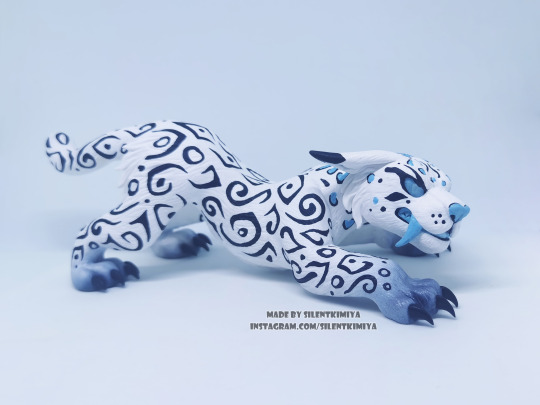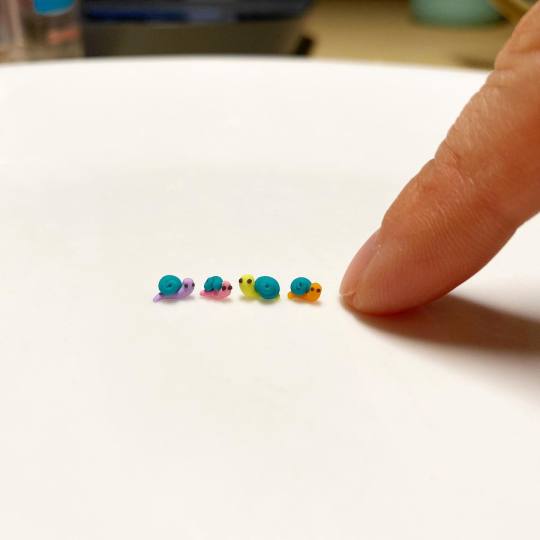#polymer processing
Explore tagged Tumblr posts
Text
How to Solve Common POM Injection Molding Defects: Shrinkage & Warpage Countermeasures
Polyoxymethylene (POM), commonly known as acetal, is a popular engineering thermoplastic prized for its excellent mechanical properties, dimensional stability, and chemical resistance. However, like all materials, POM presents specific challenges during injection molding, particularly with shrinkage and warpage defects. These issues can compromise part quality and functionality if not properly…
#mold design#plastic defects#polymer processing#POM injection molding#process optimization#shrinkage#warpage
0 notes
Text
Making resin eyes for my sculptures.
I filmed the full process in case it helps someone who wants to give it a try.
#resineeyes#resincraft#sculptingprocess#art#oddities#handmadeeyes#weird stuff#miniatureart#artist on tumblr#art process#polymer clay
379 notes
·
View notes
Text










The sculptures of Loque'Nahak from World of Warcraft - two fluffy protectors of Vulpera :)
Handmade of polymer clay, air-dry clay, painted with acrylic colors and coated with a protective matte lacquer. All blue elements glow in the dark. Custom order, one of a kind.
#silentkimiya#handmade#sculpture#figurine#figure#statuette#world of warcraft#polymer clay#art#ooak#work in progress#work in process#loque'nahak#leopard#snow leopard#glow in the dark
122 notes
·
View notes
Text
Pronoun Beads: Step By Step
Our pronoun beads are handmade with polymer clay, through a concept called clay canes. Canes are long pieces of clay with a design in the inside. You've seen this concept in action if you've ever made slice and bake cookies with a holiday design in them.

One of the main concepts of canes is that they can be changed in size, and the design will remain the same, just growing or shrinking.
So, let's start with our "he" cane. I've actually already made it longer and skinnier than when it started; I just forgot to take pictures of that part. It's about half the cross section size, and double the thickness, of the original. Above it, you can see the cutters used to make the design, which might give you an idea of how much it's already shrunk.

The letters look really weird, don't they? Don't worry! This is normal. The ends of the canes will be scrap clay, but we'll still get plenty of beads.
Once I get it a little longer, instead of pressing and pulling, I can flop it onto my acrylic board, and this will stretch it out.

It's very fun, because you can do it pretty fast without doing anything to the design.

1-800-R-U-SLAPPIN
The more we stretch the cane, the weirder the ends will look.

When it gets too long to slap on the board, I cut it in half, and only work with one piece, letting the other stay at the larger size. This is an exciting part because it's very reaffirming to cut into the middle of the cane and see your design still totally okay in there.

It worked! The design is safe and sound.
Now we keep this up until the cross section is much smaller. In my case, it needs to match with 6/0 seed beads, with are 4mm across. So I want a letter height of about 4-5mm.

So tiny!
Then I'll let these canes rest. But just for the sake of this post, I'll cut a few, to show you what the beads will look like.

And here's one chilling on a q-tip for scale.

These tiny dudes will be made into charms and earrings, and I would love to hear what else you'd like to see them in!
Here are some finished charms!

73 notes
·
View notes
Text

instagram
Process: Cheese 🩵✨🌈
Maybe I'll make dark and hero chao next
#art#artist#sonic the hedgehog#sonic#cute#sonic fanart#handmade#art process#adorable#blue#sonic chao#chao garden#cheese the chao#cream and cheese#colorful art#cute charms#polymer clay#polymer clay charms#polymer clay art#clay#clay art#clay charms#sonic fandom#sonic art#sonic characters#sega sonic#cute things#Instagram
23 notes
·
View notes
Text

Ultrasound unlocks a safer, greener way to make hydrogels
Researchers at McGill University, in collaboration with Polytechnique Montréal, pioneered a new way to create hydrogels using ultrasound, eliminating the need for toxic chemical initiators. This breakthrough offers a faster, cleaner and more sustainable approach to hydrogel fabrication, and produces hydrogels that are stronger, more flexible and highly resistant to freezing and dehydration. Hydrogels are gels composed of polymers that can absorb and retain large amounts of water. They are widely used in wound dressings, drug delivery, tissue engineering, soft robotics, soft contact lenses and more. The new method, now published in Advanced Science, also promises to facilitate advances in tissue engineering, bioadhesives and 3D bioprinting.
Read more.
18 notes
·
View notes
Text
I've been ill and really bored lately soooooo I decided to make a Hiori figurine out of polymer clay lol




@1ns3nsitiv3 not exactly fanart, but I figured you might appreciate it as well :]
#it's like the 3rd time I've ever made a figurine out of polymer clay#the first time in at least a year at that#there is like a million flaws but idc I'm proud#also while baking i fucked up the weight distribution#hence the uhhh the popsicle sticks#i might make him a proper support stand whatever tf you call it#so yea#it took me 1.5 days total?#an interesting process#hiori yo#blue lock#bllk#yo hiori#i love him sm#also i could not use a camera if my life depended on it
23 notes
·
View notes
Text

Smollest snails to ever snail 🐌
#process#snails#tiny#miniature#smol#handmade#handmade art#polymer clay#sculpture#my art#SimonSaysMacy
312 notes
·
View notes
Text
A little painting snippet of a Rainbow Moon for the upcoming Star Garden collection. 🌟
This moon is actually just one piece of a set and I can't wait to show the rest... 🌈
#maidarlingdesigns#figurine#miniature#polymer clay#maidarling#polymerclay#kawaii#handmade#sculpture#cute animals#Figurines#Painting#How to paint#Acrylic paint#Acrylic painting#Process#Art process#How to#Process video#art timelapse#Moon#Rainbow#Lisa frank#Art#90's#Miniatures#Clay#Clay art#Sculpting#how to make
61 notes
·
View notes
Text
Update on the V1 clay thing (the other post got too long!!)
Step 7 (wing holders):
Finally. This is the last big addition to the body. After this, I'm gonna do a last control bake to fix all the cracked and rough areas and also add details to the chest. (and then I'll sculpt some weapons!)

I had issues figuring out a way to make wing holders that would both stick to the wire and have space in the middle to glue the wings in. I ended up using axial symmetry to be able to fold them around the wire, and then I put aluminum foil between the two halves to make sure they wouldn't close while baking.
The aluminum foil on top of them was a way to align them all together, if that makes sense. I also placed aluminum foil balls under the wings for support. I didn't press too hard on them to avoid leaving marks and to be sure they'd be easy to remove.

It looks like this when cured, and honestly I'm really happy with it. The other 4 broke because they were too thin but I remade them.


And here they are! Sexiest wings of the century
After this I'm gonna add details, glue beneath the less stable parts and start nail filing some bits here and there. Maybe I'm gonna see the end of this.
#my little v1 project#v1#art#v1 ultrakill#ultrakill#polymer clay#clay#creative process#ill take beautiful pics once this is all done#but we're seeing the end of it!
28 notes
·
View notes
Text




Hello Tumblr! We’re Matt & Emilie, a Frenglish duo making art & crafts. 🇫🇷🇬🇧
We work with wood, watercolors, polymer clay, and whatever else inspires us. Our style? A mix of DIY chaos, geeky fun, and a love for handmade things. ✨🔨 Matt’s often in the workshop, shaping wood and making things from scratch. 🛠️ Emilie loves to bring projects to life in different mediums.
This year, we’re sharing our creative journey—both the successes and the inevitable “what have we done” moments. Follow along if you like: ✅ Artsy messes ✅ Crafting experiments ✅ Handmade goods with a dash of chaos
✨ Let’s be friends & make cool stuff together! ✨
P.S. We also have a shop where you can find our handmade pieces! ➡ https://ko-fi.com/frenglishexpedition/shop
#artist on tumblr#handmade#artists on kofi#woodworking#polymer clay#watercolor#diy#art community#creative process
4 notes
·
View notes
Text
Just a glimpse of the process for this one.
#artist on tumblr#art#oddities#polymer clay#sculpture#art doll#art process#strange art#artwork#surreal art
43 notes
·
View notes
Text






Handmade sculpture of Blood Elf from World of Warcraft, sculpting in progress. It's interesting to watch the sculpture change step by step, isn't it? ;)
#silentkimiya#handmade#sculpture#figurine#statuette#figure#wip#work in progress#work in process#art in progress#art in process#sculpting wip#polymer clay#world of warcraft#elf#blood elf
11 notes
·
View notes
Text
Hey all 👋
Since I have nothing better to post I thought I'd take you all through the process of what I did to make my dark chaos chao figure.

1. First I drew a thumbnail sketch to get an idea of what I wanted the pose to be.

2. Then I modelled each part using polymer clay; I kept each part seperate so that it would be easier to paint them.
This photo shows the aftermath of me baking each part and sanding down the edges as best as I could.

3. I went over each part using chalk pastel.
However, I would eventually go over each piece using acrylic paint since the chalk pastel wasn't strong enough.

4. I then coated each part using matt spray so that the chalk pastel wouldn't rub off so easily.

5. Then, I went over each piece using acrylic paint; adding some details along the way e.g. the eyes.

6. I then glued each piece together using gorilla glue and coated each piece with satin glaze (funnily enough it gave it a shiny look even though I was going for a matt look).

7. I then modelled the stand out of polymer clay, baked it and sanded off the edges (ignore the zits).

8. And here's the final product with the stand painted and the fireball which I made out of felt and attached it to a metal wire to make it look like it was floating.

I had to delay this project at some point due to it breaking apart while I was cleaning.
I glued it back together but it left some glue residue. So I repainted some parts, which involved scraping off large globs of glue (and paint) and added another layer of glaze
And that's that.
Let me know if you have any questions about the process. 😊👩🎨✨
#sth#sonic the hedgehog#sonic fanart#sonic fandom#sonic the hedghog fanart#chao garden#chao world#chaos chao#sa2b#sonic adventure 2#sonic adventure 2 battle#polymer clay#polymerclay figure#chalk pastel#acrylic paint#art process#art blog#myart#my art <3#my art blog#art project#2024 post#Spinch-San
11 notes
·
View notes
Text
Process images for To See You:








#Sumi art#Art process#Not fanart#Traditional art#I regret not using polymer clay for the standing girl. It could have been more dynamic. I did have fun creating her scarf.#I imagined an encounter a person might have on the way home from the bus stop on a winter day.
5 notes
·
View notes
Text

Catalytic process vaporizes plastic bags and bottles, yielding gases to make new, recycled plastics
A new chemical process can essentially vaporize plastics that dominate the waste stream today and turn them into hydrocarbon building blocks for new plastics. The catalytic process, developed at the University of California, Berkeley, works equally well with the two dominant types of post-consumer plastic waste: polyethylene, the component of most single-use plastic bags; and polypropylene, the stuff of hard plastics, from microwavable dishes to luggage. It also efficiently degrades a mix of these types of plastics. The process, if scaled up, could help bring about a circular economy for many throwaway plastics, with the plastic waste converted back into the monomers used to make polymers, thereby reducing the fossil fuels used to make new plastics. Clear plastic water bottles made of polyethylene tetraphthalate (PET), a polyester, were designed in the 1980s to be recycled this way. But the volume of polyester plastics is minuscule compared to that of polyethylene and polypropylene plastics, referred to as polyolefins.
Read more.
#Materials Science#Science#Catalysts#Plastics#Polymers#Materials processing#UC Berkeley#Waste#Recycling
54 notes
·
View notes